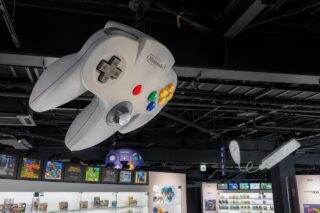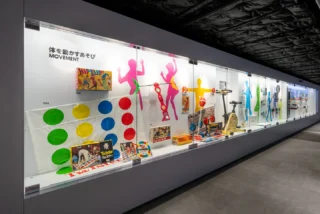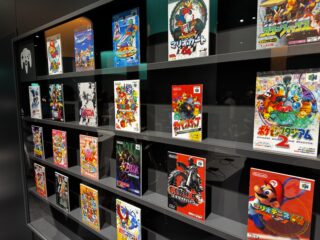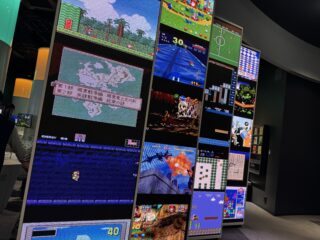The prototype Wii-Motes on display were fascinating. These prototypes that have been previously shown were all on display, as were prototypes I’d never seen. pic.twitter.com/agPvqiqS8E
— Kyle McLain (@FarmboyinJapan) October 3, 2024
Review: Right now, Nintendo’s Museum is mostly shallow fun – and that’s OK
The just-opened Kyoto museum offers nostalgic thrills, but teaches visitors little about how the magic was made

As of this summer, Nintendo Swich has officially had the longest lifespan of any Nintendo home console, but, as a popular social media gag goes, the company’s biggest gap between hardware was actually the 94 years between 1889 and 1983. And whether or not you get the joke will determine how much you’ll enjoy Japan’s Nintendo Museum.
Opened this month in the company’s Uji Ogura Plant in Kyoto, Japan, which was previously used as a factory and console repair centre, the Nintendo Museum is a showcase of the Super Mario firm’s 135-year history, from playing cards, to taxis and love testers, to the modern handheld and home game hardware its best known for.

However, by Nintendo’s own admission on its website, this is no deep dive into the creation of its iconic video games. No “special knowledge or familiarity with video games” is required to make the most of your visit, it says, and the Museum’s exhibits are, in fact, “shared with little explanation”.
This is less a Nintendo ‘Museum’ then, and more of a product showroom. Intriguingly, Nintendo’s first announcement referred to it as a “gallery”, which feels more appropriate. If you enter with these expectations, you’re more likely to appreciate the venue as an all-round celebration of ‘The Big N’, rather than a thesis on how the magic was made.
As is typical with all Nintendo buildings, the Museum’s great exterior is surprisingly bland from the outside, but once you clear the Airport-like security at its entrance, a far more colourful and captivating forecourt awaits. Here, the Museum sets expectations for the S-tier nostalgia bait that’s to come, with an obligatory scattering of Super Mario pipes, blocks and iconography, but also, if you explore further, a GameBoy-themed locker room, a Pikachu manhole cover, and even a Kirby vending machine.
From here, you have the choice of entering two buildings. The main museum is split across two floors: one contains a thoughtfully assembled gallery of Nintendo’s past and present products. The second floor contains various interactive exhibits, which put a modern twist on some of the company’s iconic past creations, such as a Super Scope/Zapper light gun game played on a wall-sized screen with 13 players, or a section where you can attempt to play classic Nintendo games with gigantic, oversized controllers.
A smaller, second building then offers visitors the opportunity – via appointment only – to learn about and craft your own Hanafuda playing cards – Nintendo’s first products – and order custom burgers in a surprisingly modestly-themed café. Finally, placed conveniently at the exit of the main building, there’s a large store absolutely stuffed with console-themed t-shirts, mugs and pins, which – for the most part – can only be purchased at the Museum. If you’re a Nintendo nut, the shop alone is almost worth the visit.
During its first months, getting into the Museum is unsurprisingly difficult, but compared to some other Japan-based tourist attractions, the ticketing experience is at least well organised and fair. Currently, those who want to visit must enter a lottery up to three months in advance. You’re able to pick three time/date slots, and if successful, you’ll be able to purchase a ticket. Reselling looks like it’s virtually impossible, as Nintendo insists that the person who purchases a ticket must bring their passport with matching name – and allegedly, even spelling errors won’t be overlooked (so don’t get married in between booking and visiting).
I arrived around 50 minutes in advance of my time slot. After checking my QR code, security gate staff directed me to a small queuing area, where I found two separate queues for my 30-minute slot, and the one before that. Due to the sheer amount of QR scanning (I counted three checks before entry), jumping ahead into the earlier queue wasn’t an option, but eventually, we were allowed to enter the Museum 20 minutes early anyway.
Once you’re done posing for photos next to the Mario pipes and venture inside Building One, a brief presentation explains how everything works. When clearing the security process, visitors are given their own personal ‘Play Ticket’, which is connected to their Nintendo account and, if you like, can feature your Mii on the front. Your Play Ticket is used to activate the interactive elements of the Museum and, if applicable, track any records you set. Some games even save photos to the ticketing site for you to download, which is a nice touch.

From here, you ride an escalator to the top floor, as your inner 12-year-old is courted from all sides by nostalgic boot-up animations from Nintendo’s classic consoles, and at the top, you find yourself at the centre of a vibrant showroom, surrounded by enticing console-themed displays, each stuffed with colourful game packaging and screens rolling gameplay footage. Overhanging each display is an oversized controller or handheld that you’ll be desperate to fondle (and later on, you might get the chance).
What immediately struck us about the product showroom was its freeform design. There is no clear path through the exhibits, and multiple layers of displays extend 360 degrees around you, so we naturally gravitated to the consoles that most appealed to us—which we suppose was the Museum’s intention. The displays are beautifully designed, with key game releases and strange peripherals laid out like works of art. On the rear of each display is a more editorialised presentation of each hardware, including callouts to its innovations, such as N64’s analogue stick or GBA’s wireless connectivity.
We were pleasantly surprised to discover that the Museum gives equal billing to even Nintendo’s less successful consoles, like the infamous Virtual Boy—which was on sale for just a year before being discontinued—and the much maligned Wii U. Even the company’s muted foray into mobile games is acknowledged with its own display, showing now-unsupported games such as Animal Crossing: Pocket Camp and Mario Kart Tour.
Around the edges are more curated exhibits, such as the evolution of the question mark block in Super Mario Bros., or screens showing how various series evolved over time, such as The Legend of Zelda or Super Mario Kart. Some exhibits focus on concepts such as movement and music, and show how these ideas have been used in Nintendo products over the years, from toys to Wii Sports.
Disappointingly, what isn’t present in the showroom is any mention what-so-ever of the people behind the products, or how they were created. Going by Nintendo’s website synopsis mentioned earlier, this isn’t a mistake: it wants the Museum experience to be accessible to any audience and, by Shigeru Miyamoto’s own admission, promoting the company rather than its products is not something Nintendo has historically been comfortable doing (Miyamoto has also suggested that a big motivation for the Museum’s creation was so that he didn’t have to brief graduates on company history every year).
Regardless, the fact that the likes of Miyamoto himself (beyond an awkwardly out-of-place signature at the museum’s entrance), Gumpei Yokoi, Hiroshi Yamauchi, Satoru Iwata and others aren’t acknowledged feels like a big oversight, whether you’re a visiting superfan or not. And if the objective was to keep the exhibits accessible, insight into the creation of Nintendo’s games could’ve surely still been shared via an optional audio tour or on-demand video content because, at launch, the product floor is beautiful and nostalgic, but also mostly shallow.

Within Japanese industry circles, it’s something of an open secret that Nintendo worked with its own veteran employees, and even some outside fan collectors, to help curate and fill this section of the museum – and you can feel it. The showroom oozes with the passion and knowledge of an ardent collector, while simultaneously repeating a lot of the same stories we’ve heard for decades from the outside. There’s also said to be a “Nintendo expert” on hand at all times to feed staff explanations via earpiece about any items in the Museum upon request – and we do wonder who is at the other end of the mic.
One welcome exception to the above, that quite clearly came directly from inside the depths of Nintendo’s own vaults, is the absolutely wonderful prototype corner – allegedly added to the museum at the very last minute, based on feedback – which had us hopeful that the overall experience could yet improve for those who already know what an Ultra Hand is – or own one.
Located in a nondescript corner of the product floor, unceremoniously laid out across a wooden table inside a glass storage room, are prototypes of various Nintendo controllers and devices. Some of these we’ve seen evidence of before, like the prototype SNES with red buttons, the Wii U with two Wii remotes strapped to it, or the infamous Wii ‘star’ controller pictured below. There’s also never-before-seen artifacts, like a horizontal Game Boy and Nintendo DS, an N64 ‘Ultra 64’ pad without the prongs, and a ‘Dolphin’ GameCube prototype.
Unfortunately, like much of the museum, photographs are not allowed in this section of the building, but the prototypes offer a fascinating glimpse behind the curtain, which as a fan who remembers seeing some of these in magazine articles literally decades ago, was a particular thrill.
There are more tantalising glimpses at unfinished products hidden elsewhere in the museum. Tucked in an exit corridor, we found equally exciting ‘reveal’ models of various consoles, like the Ultra 64 and lime green Wii. The DS and GBA pre-launch models, in particular, transported me back in time to when I first got to try them at ECTS 2001 and E3 2004 as a teenager. I never thought I’d see them again in the flesh, and yet there they were, behind a glass display case, inches in front of me.
As a fan, it was genuinely brilliant to see these unspeakably rare trinkets up close, but in reality, there are few of them, many clearly added at the last minute, which only further highlighted the lack of behind-the-scenes insight elsewhere in the museum. The lack of any sort of written explanation felt particularly awkward here too, with tourists probably wondering what the hell they were looking at, and absolutely everyone bemused at how that Wii star controller was actually supposed to be used.
This imbalance extended to the second, lower floor, which is where all of the Museum’s interactive experiences are located. There are eight experiences in all, the most significant for fans being the Super Scope and Big Controller games, as well as an Ultra Machine batting cage experience – which has you wielding a baseball bat inside an 80s-era Japanese living room – and Ultra Hand SP, which has players using the 60s grabbing toy to catch balls and put them down a pipe.
The remaining four – an LED floor card matching game, Kinect-like Love Tester and Game & Watch experiences, and an area filled with – essentially – time-limited Nintendo Switch Online retro games – lacked depth, but at least required less time standing in a queue (the more popular games had waiting times of up to 30 minutes, while others had virtually no wait times at all).
Here’s a bit more detail on how the games work:

- Zapper & Scope SP, as its name suggests, has 13 players blasting Mario baddies across a wall-sized screen. You can pick either a NES Zapper or a SNES Super Scope, and at the end of the game the top three players are crowned (with your ‘trophy’ stored on the records section of the Museum site).

- Ultra Machine SP takes place in a batting cage themed around a Japanese 80s living room. Balls are fired towards the player, and if you bat them back at various items in the room, they’ll play a musical jingle or react in other ways. Photos from this experience are uploaded to your profile on the Museum site.

- Shigureden SP takes place on a beautiful floor-sized screen at the very center of the second floor. Players are handed a smart device to read Tanka poems on the floor (thankfully available in English), after which they need to search for the second half of that poem on a matching card. Points are awarded based on how fast you collect the cards.

- Ultra Hand SP sees players using the 60s toy to grab balls from a moving conveyor belt, and then place them inside a pipe. You’re then rewarded with various screen effects based on the size of the ball and which pipe you place it into.

- Love Tester SP is an EyeToy / Kinect-style game which has two players holding hands and completing various games, such as washing windows and manoeuvring to catch Mario hats onto their heads.

- Game & Watch SP is another Kinect-style game in which you use your projected shadow to play either Ball or Manhole.

- Nintendo Classics offers a selection of NES, SNES and N64 games which can be played by up to two players for seven minutes. Disappointingly, these aren’t running on original hardware.

- Big Controller, as its name suggests, offers several classic N64, SNES, Famicom and Wii games, which can be played by two players on giant controllers, as short gameplay challenges. Players must choose which system they’d like to play in advance, and solo visitors sadly can’t attempt them.
The big catch on this floor is that the games that you can play are all capped in various ways. Two of them – Love Tester and the aforementioned Big Controller games – can only be played by two players, and if you’re visiting the museum as a solo visitor – tough luck, because staff won’t help you play them (though this could be a good excuse to buddy up with your fellow museum loners).
There’s also a hard cap across all games, as the Play Cards mentioned earlier will only allow visitors to try a few experiences per visit. Each visitor’s card comes fuelled with ten ‘coins’, with each interactive game taking a different amount away. Most exhibits cost two coins, so you definitely won’t be able to try everything in a single visit. And if you want to try multiple games in the Big Controller or Nintendo Classics area, you could see even less during a visit which, let’s not forget, requires a ticket won via lottery months in advance – not to mention a once-in-a-lifetime international trip for many.

Beyond the interactive exhibits, other than beautiful collections of Nintendo’s pre-gaming era toys and cards, lies the exit door, flanked by one of the only items in the entire Museum to receive a written explanation: a framed piece of calligraphy art gifted to Nintendo to mark the opening of its headquarters in the 1970s, often seen behind late president Satoru Iwata during his Nintendo Direct broadcasts. The explanation refers to the perceived meaning of Nintendo’s name: “leave luck to heaven”, but notes that this interpretation is unconfirmed.
What’s left is to waddle off and spend hundreds on oversized Wii Remote pillows and golden Hanafuda cards in the museum store. The merchandise is mainly themed around 15 Nintendo consoles, each of which has its own t-shirt, mug, stickers, pen, and pin set. The 15 consoles are Famicom, NES, Famicom Disk System, Game Boy, Super Famicom, SNES, Virtual Boy, Nintendo 64, Game Boy Advance, GameCube, Nintendo DS, Wii, Nintendo 3DS, Wii U and Switch.
In addition, there are Nintendo Museum-themed t-shirts, glasses, lanyards, hats, plates, and more. The standout items though, are the replica Ultra Hand, the special edition Hanafuda and Hyakunin Isshu sets, giant Wii / SNES / Famicom / N64 pillows, and the miniature controller keyrings. Nintendo historian Before Mario has put together a list of every item available in the store:
The quality of items here, especially for fans, is fantastic, though again, there are some pains during the opening weeks. During my visit, many popular items – such as miniature controller keyrings or that stunning re-creation of the 60s Ultra Hand toy – were sold out, while Nintendo has put hard caps on other items such as pillows and pins, meaning I couldn’t buy any duplicates for friends back home.
It’s easy to see how the Nintendo Museum’s early issues might disappoint some stalwarts who’ve made the long journey to Kyoto, expecting a mecha for nerds. However, as I reluctantly handed over my credit card and carried several bags of unnecessary swag on a final lap tour of the main building, I started to notice details I hadn’t before, like a group of Pikmin carrying a Wii Remote, a Samus morph ball hiding in the ceiling pipage, and a floating Animal Crossing present above the café.

When the Nintendo Museum is viewed in this light, as a spirited showcase of all the beloved memories you have for the company and its creations, you can truly appreciate it for what it is right now: a fun day out that reminds you of why you fell in love with Nintendo in the first place.
Some will surely be disappointed by the lack of depth from its exhibits, but if you go in with the expectation that you’re likely to leave having learned very little, beyond how to pack a human-sized N64 controller into a suitcase, you’ll likely have a more enjoyable experience overall. I can already imagine that returning with my family, so that my young daughters can enjoy the interactive exhibits together and enjoy their own memories of Nintendo’s games, will elevate the experience greatly.
There are also signs the museum could meaningfully evolve, of course, not least from those fascinating prototypes haphazardly assembled on the second floor. Either way, it would take a stone-hearted Thwomp to leave without taking at least a little joy from this trip down memory lane.










































